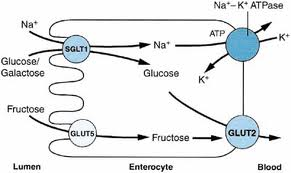Absorption of Carbohydrates
In the small intestine, some cells have the specialized membranes which contain the various transport proteins to get the monosaccharides and the other nutrients to the blood from where they are distributed to the rest of the body. The first organ of the body that receives the glucose, fructose, and galactose is the river. The liver takes up these molecules and causes the conversion of the galactose to the glucose and causes the breakdown of the fructose to even smaller and carbon-containing sub units and stores them either as glucose, glycogen, or it may be exported back to the blood. The amount of glucose that is exported back to the blood is under the control of hormones. Once the galactose and the fructose are absorbed, they are metabolized by the liver for producing glucose and some other metabolites. However, the concentration of the fructose reaching the bloodstream is very small. But the co-ingestion of the fructose and the glucose causes the absorption of fructose.

Role of Intestine for Absorption of Carbohydrates
Once the carbohydrates are broken down into their subsequent sub units they can be quickly absorbed along with the lower and the upper parts of the small intestine. There are small finger-like projections known as the villi which are specialized for the absorption of carbohydrates. Then the smaller units of the carbohydrates are transferred to the bloodstream from where they are carried to the liver and the muscles. The level of the small sub units of the carbohydrates such as glucose is highly controlled and any change in its normal concentration will cause negative health consequences.

Assimilation of Carbohydrates
Initially, the surplus glucose that is the sub unit of carbohydrates is stored in the form of glycogen in the muscles, or the liver. Approximately 100 grams of glycogen can be stored by the liver, which is used for maintaining the blood glucose levels in between the meal times. The muscles stores about 400-500 grams of glycogen and it is used for the movements. Once, if the reserves got saturated then the excess glucose is converted to the fats and it is stored for the longer terms.
The energy from the carbohydrates and the other molecules such as proteins and fats is required for the normal functioning of the body. Consumption of more energy than the requirement causes the assimilation of their subsequent units in the forms of fats.